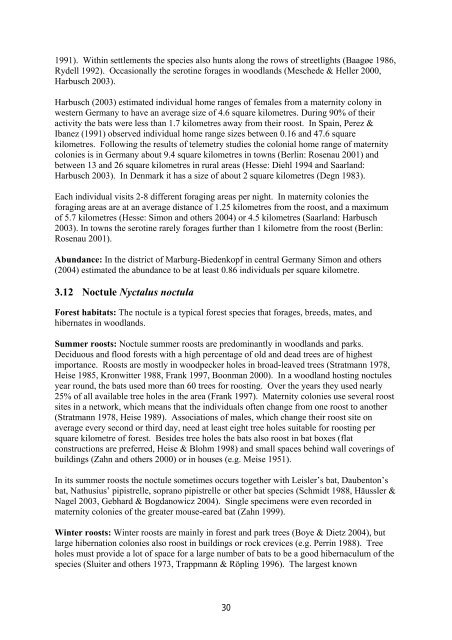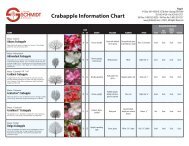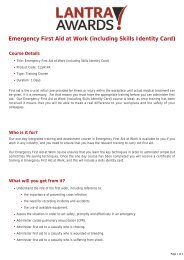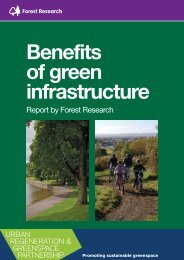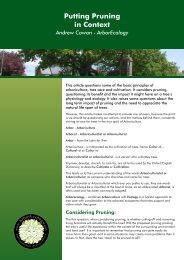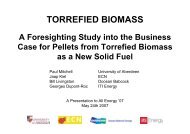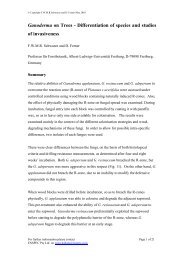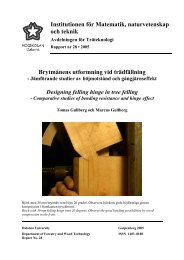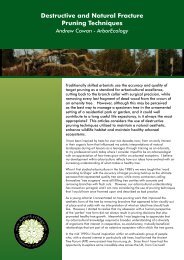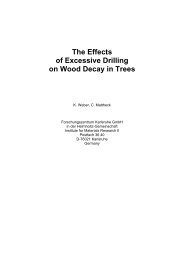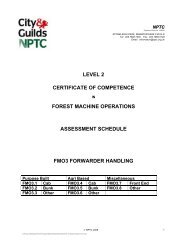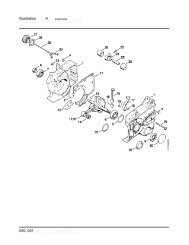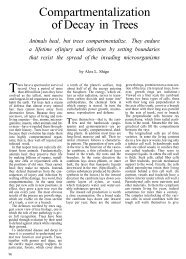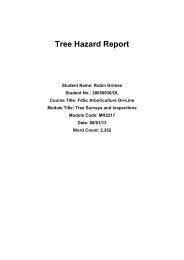1991). Within settlements the species also hunts along the rows of streetlights (Baagøe 1986,Rydell 1992). Occasionally the serotine <strong>for</strong>ages in woodlands (Meschede & Heller 2000,Harbusch 2003).Harbusch (2003) estimated individual home ranges of females from a maternity colony inwestern Germany to have an average size of 4.6 square kilometres. During 90% of theiractivity the bats were less than 1.7 kilometres away from their roost. In Spain, Perez &Ibanez (1991) observed individual home range sizes between 0.16 and 47.6 squarekilometres. Following the results of telemetry studies the colonial home range of maternitycolonies is in Germany about 9.4 square kilometres in towns (Berlin: Rosenau 2001) andbetween 13 and 26 square kilometres in rural areas (Hesse: Diehl 1994 and Saarland:Harbusch 2003). In Denmark it has a size of about 2 square kilometres (Degn 1983).Each individual visits 2-8 different <strong>for</strong>aging areas per night. In maternity colonies the<strong>for</strong>aging areas are at an average distance of 1.25 kilometres from the roost, and a maximumof 5.7 kilometres (Hesse: Simon and others 2004) or 4.5 kilometres (Saarland: Harbusch2003). In towns the serotine rarely <strong>for</strong>ages further than 1 kilometre from the roost (Berlin:Rosenau 2001).Abundance: In the district of Marburg-Biedenkopf in central Germany Simon and others(2004) estimated the abundance to be at least 0.86 individuals per square kilometre.3.12 Noctule Nyctalus noctulaForest habitats: The noctule is a typical <strong>for</strong>est species that <strong>for</strong>ages, breeds, mates, andhibernates in woodlands.Summer roosts: Noctule summer roosts are predominantly in woodlands and parks.Deciduous and flood <strong>for</strong>ests with a high percentage of old and dead trees are of highestimportance. Roosts are mostly in woodpecker holes in broad-leaved trees (Stratmann 1978,Heise 1985, Kronwitter 1988, Frank 1997, Boonman 2000). In a woodland hosting noctulesyear round, the bats used more than 60 trees <strong>for</strong> roosting. Over the years they used nearly25% of all available tree holes in the area (Frank 1997). Maternity colonies use several roostsites in a network, which means that the individuals often change from one roost to another(Stratmann 1978, Heise 1989). Associations of males, which change their roost site onaverage every second or third day, need at least eight tree holes suitable <strong>for</strong> roosting persquare kilometre of <strong>for</strong>est. Besides tree holes the bats also roost in bat boxes (flatconstructions are preferred, Heise & Blohm 1998) and small spaces behind wall coverings ofbuildings (Zahn and others 2000) or in houses (e.g. Meise 1951).In its summer roosts the noctule sometimes occurs together with Leisler’s bat, Daubenton’sbat, Nathusius’ pipistrelle, soprano pipistrelle or other bat species (Schmidt 1988, Häussler &Nagel 2003, Gebhard & Bogdanowicz 2004). Single specimens were even recorded inmaternity colonies of the greater mouse-eared bat (Zahn 1999).Winter roosts: Winter roosts are mainly in <strong>for</strong>est and park trees (Boye & Dietz 2004), butlarge hibernation colonies also roost in buildings or rock crevices (e.g. Perrin 1988). Treeholes must provide a lot of space <strong>for</strong> a large number of bats to be a good hibernaculum of thespecies (Sluiter and others 1973, Trappmann & Röpling 1996). The largest known30
hibernaculum is the Levensau Bridge in northern Germany where about 5,000 specimenscome together in early winter (Harrje 1994, Kugelschafter 1994).In their winter roosts the noctule was observed together with Leisler’s bat and the commonpipistrelle (Boye and others 1999, Gebhard & Bogdanowicz 2004).During migration it is possible that very large numbers of bats occur at places where fewanimals live during summer. This happens mainly in valleys of large rivers and in lakedistricts, which obviously have an important function during the seasons due to a lot of preyinsects there (Meschede & Heller 2000, Weid 2002).Summer and winter roosts can be very distant from one another; more than 1,000 kilometresis not unusual. Specimens living in north-eastern Germany during summer are regularlyfound in south-western Germany or Switzerland during winter (Boye and others 1999). Inother European regions the preferred direction of migrations is not yet known. The greatestmigration distance is about 1,600 kilometres (Boye & Dietz 2004).Other roosts: In late summer and autumn males occupy special mating roosts where theybehave territorially and advertise with specific mating calls (Gloza and others 2001). Inmating areas such roosts have to be close to each other, so that passing females are attractedand interrupt their migration (Meschede & Heller 2000).Foraging areas: Foraging areas may be in several parts of the landscape, all of which host ahigh abundance of insect fauna and offer the space in the air needed by the fast flyingnoctule. Large water bodies, valley pastures and open <strong>for</strong>ests are preferred, but the bats also<strong>for</strong>age in other habitats, and even above harvested fields and lighted places in towns (Austria:Spitzenberger 2001, Czech Republic: Gaisler and others 1979, Denmark: Baagøe 2001a,Germany: Meschede & Heller 2000, Greece: Hanak and others 2001, Rottmann and others2003, Hungary: Dobrosi n.y., Italy: Spagnesi and others 2000, Luxembourg: Harbusch andothers 2002, Poland: Rachwald 1992, Spain and Portugal: Benzal and others 1991,Switzerland: Stutz & Haffner 1989, Gebhard & Zingg 1995, The Netherlands: Limpens &Kapteyn 1991). The noctule visits each individual <strong>for</strong>aging area each night in the samesequence (Kronwitter 1988).Noctule bats can easily make <strong>for</strong>aging flights more than 10 kilometres away from the roostsite (Meschede & Heller 2000), up to a maximum of 20 kilometres (Limpens and others1997, Heise 1999). However, the main activity of a maternity colony is within a radius ofabout 2 kilometres from the colony’s roost (Schmidt 1988).3.13 Leisler’s bat Nyctalus leisleriForest habitats: Leisler’s bat or the lesser noctule is also a typical woodland species, as itoccurs in many <strong>for</strong>est types and mostly roosts in trees.Summer roosts: Summer roosts are in tree holes, tree crevices, bird or bat boxes and morerarely in buildings or between timbers (Shiel & Fairley 2000, Braun & Häussler 2003,Bogdanowicz & Ruprecht 2004). Roosts in trees can be found from about 1.5 metres abovethe ground up to the canopy (Ruczynski & Ruczynska 2000). In some regions woodpeckerholes in side branches are preferred, if the bats can approach them from below (Günther andothers 1991, Ruczynski & Ruczynska 2000). Three individuals studied by radiotelemetry in31
- Page 3: English Nature Research ReportsNumb
- Page 7 and 8: ContentsPreamble1. Legal aspects...
- Page 9 and 10: 1. Legal aspectsThere are three int
- Page 11 and 12: to the Agreement decided that the c
- Page 13 and 14: Country European Community EUROBATS
- Page 15 and 16: types in Europe where many of the e
- Page 17 and 18: • the European Commission initiat
- Page 19 and 20: Foraging areas: Central European sp
- Page 21 and 22: Other roosts: In foraging areas and
- Page 23 and 24: Brandt’s bat travels up to 250 ki
- Page 25 and 26: others 2004). Maternity colonies al
- Page 27 and 28: 1995, The Netherlands: Limpens and
- Page 29: from a maternity colony covered a t
- Page 33 and 34: female (Fuhrmann and others 2002).
- Page 35 and 36: Foraging areas: In Central Europe f
- Page 37 and 38: Table 2 Importance of tree holes fo
- Page 39 and 40: sites it was found that the possibi
- Page 41 and 42: advancing age of a tree its potenti
- Page 43 and 44: floor up to the canopy and beyond c
- Page 45 and 46: Table 6 Overview of the most freque
- Page 47 and 48: 6.2 2nd step: Active search for roo
- Page 49 and 50: This first approach to a woodland b
- Page 51 and 52: number of tree-dwelling birds in pr
- Page 53 and 54: Types of boxes used by batsThere ar
- Page 55 and 56: oxes exposed to the sun. As an exam
- Page 57 and 58: Con: Bats use bat boxes selectively
- Page 59 and 60: 9. ReferencesABULADZE, A., BUXNIKAS
- Page 61 and 62: BEKKER, J.P. 1990. Ervaringen met v
- Page 63 and 64: BRAUN, M., & HÄUSSLER, U. 2003c. K
- Page 65 and 66: Ökologie und Verbreitung von Arten
- Page 67 and 68: (Germany). In: PRIEDE, I. G. & SWIF
- Page 69 and 70: (Nyctalus leisleri) sowie zur Besie
- Page 71 and 72: HEISE, G. 1985. Zu Vorkommen, Phän
- Page 73 and 74: JONES, G. 1990. Prey selection by t
- Page 75 and 76: (Chiroptera: Vespertilionidae). - P
- Page 77 and 78: Ökologie und Verbreitung von Arten
- Page 79 and 80: PÉREZ, J. L. & IBÁÑEZ, C. 1991.
- Page 81 and 82:
ROTTMANN, R., BOYE, P. & MEINIG, H.
- Page 83 and 84:
SCHORCHT, W., and others. 2002. Zur
- Page 85 and 86:
STUTZ, H.-P. B. & HAFFNER, M. 1989.
- Page 87 and 88:
WAGNER, M., KERTH, G. & KÖNIG, B.
- Page 89:
10. AuthorsDr. Peter Boye became fa


